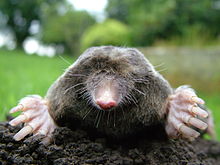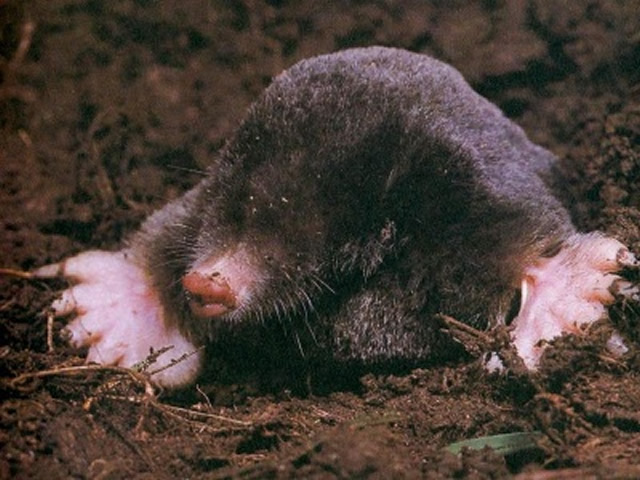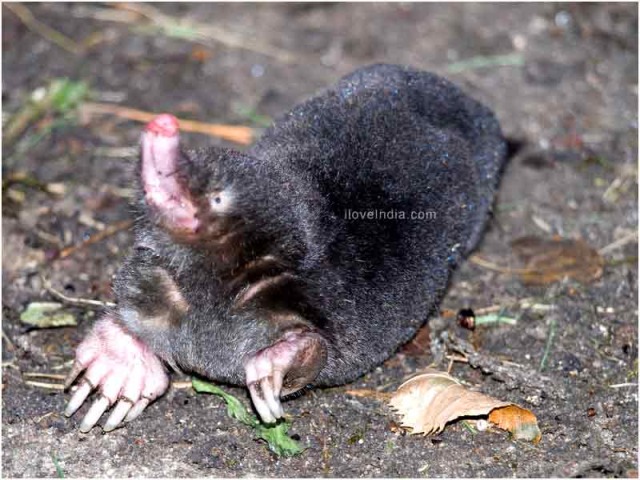Source:- Google.com.pk
Mole Animal Pictures Biography
He star-nosed mole (Condylura cristata) is a small mole found in wet low areas of eastern Canada and the north-eastern United States, with records extending along the Atlantic coast as far as extreme southeastern Georgia.[3] It is the only member of the tribe Condylurini and the genus Condylura.
Star-nosed moles are easily identified by the eleven pairs of pink fleshy appendages ringing their snout which are used as a touch organ with more than 25,000 minute sensory receptors, known as Eimer's organs, with which this hamster-sized mole feels its way around. With the help of their Eimer's organs, they may be perfectly poised to detect seismic wave vibrations.[4]
Contents [hide]
1 Description
2 Ecology and behavior
3 References
4 External links
[edit]Description
The star-nosed mole is covered in thick blackish brown water-repellent fur and has large scaled feet and a long thick tail, which appears to function as a fat storage reserve for the spring breeding season. Adults are 15 to 20 cm in length, weigh about 55 g, and have 44 teeth. The mole's most distinctive feature is a circle of 22 mobile, pink, fleshy tentacles at the end of the snout, from which they derive their name. These are used to identify food by touch, such as worms, insects and crustaceans.
The extremely sensitive nasal tentacles are covered with minute touch receptors known as Eimer's organs. The nose is approximately one centimeter in diameter with approximately 25,000 Eimer's organs distributed on 22 appendages. Eimer's organs were first described in the European mole in 1871 by German zoologist Theodor Eimer. Other mole species also possess Eimer's organs, though they are not as specialized or numerous as in the star-nosed mole. Because the star-nosed mole is functionally blind, it had long been suspected that the snout was used to detect electrical activity in prey animals,[5] though little, if any, empirical support has been found for this hypothesis. It appears the nasal star and dentition of this species are primarily adapted to exploit extremely small prey. A report in the journal Nature gives this animal the title of fastest-eating mammal, taking as short as 120 milliseconds (average: 227 milliseconds) to identify and consume individual food items. Its brain decides in the ultra short time of 8 ms if a prey is comestible or not. This speed is at the limit of the speed of neurons. These moles also possess the ability to smell underwater, accomplished by exhaling air bubbles onto objects or scent trails and then inhaling the bubbles to carry scents back through the nose.[6]
[edit]Ecology and behavior
The star-nosed mole lives in wet lowland areas and eats small invertebrates, aquatic insects, worms and mollusks. It is a good swimmer and can forage along the bottoms of streams and ponds. Like other moles, this animal digs shallow surface tunnels for foraging; often, these tunnels exit underwater. It is active day and night and remains active in winter, when it has been observed tunneling through the snow and swimming in ice-covered streams. Little is known about the social behavior of the species, but it is suspected that it is colonial.
The star-nosed mole mates in late winter or early spring, and the female has one litter of typically 4 or 5 young in late spring or early summer. However, females are known to have a second litter if their first is unsuccessful. At birth, each offspring is about 5 cm long, hairless, and weighs about 1.5 g. Their eyes, ears, and star are all sealed, only opening and becoming useful approximately 14 days after birth. They become independent after about 30 days, and are fully mature after 10 months.
Predators include the Red-tailed Hawk, Great Horned Owl, various skunks and mustelids, large fish as well as domestic cats.
[edit]References
^ Hutterer, Rainer (16 November 2005). Wilson, Don E., and Reeder, DeeAnn M.. ed. Mammal Species of the World (3rd ed.). Baltimore: Johns Hopkins University Press, 2 vols. (2142 pp.). pp. 300–301. ISBN 978-0-8018-8221-0. OCLC 62265494.
^ Hammerson, G. (2008). "Condylura cristata". IUCN Red List of Threatened Species. Version 2009.2. International Union for Conservation of Nature. Retrieved 09 February 2010.
^ Feldhamer, George A.; Thompson, Bruce C.; Chapman, Joseph A., eds. (2003). Wild Mammals of North America: Biology, Management and Conservation (2nd. ed.). Baltimore, Maryland: Johns Hopkins University Press.
^ Catania, Kenneth C. (June 2000). "A Star is Born". Natural History Magazine. Retrieved March 2010.
^ Gould, Edwin; McShea, William; Grand, Theodore (1993). "Function of the Star in the Star-Nosed Mole, Condylura cristata". Journal of Mammalogy (American Society of Mammalogists) 74 (1): 108–116. DOI:10.2307/1381909. JSTOR 1381909.
^ Catania, K.C. (2006-12-21). "Olfaction: Underwater 'sniffing' by semi-aquatic mammals". Nature 444: 1024–1025. DOI:10.1038/4441024a.
Catania, K.C. (1999). "A nose that looks like a hand and acts like an eye: the unusual mechanosensory system of the star-nosed mole". Journal of Comparative Physiology A 185 (4): 367–372. DOI:10.1007/s003590050396.
Catania, Kenneth C.; Fiona E. Remple (2005). "Asymptotic prey profitability drives star-nosed moles to the foraging speed limit"]. Nature 433 (7025): 519–522. DOI:10.1038/nature03250








Mole Animal Pictures Biography
He star-nosed mole (Condylura cristata) is a small mole found in wet low areas of eastern Canada and the north-eastern United States, with records extending along the Atlantic coast as far as extreme southeastern Georgia.[3] It is the only member of the tribe Condylurini and the genus Condylura.
Star-nosed moles are easily identified by the eleven pairs of pink fleshy appendages ringing their snout which are used as a touch organ with more than 25,000 minute sensory receptors, known as Eimer's organs, with which this hamster-sized mole feels its way around. With the help of their Eimer's organs, they may be perfectly poised to detect seismic wave vibrations.[4]
Contents [hide]
1 Description
2 Ecology and behavior
3 References
4 External links
[edit]Description
The star-nosed mole is covered in thick blackish brown water-repellent fur and has large scaled feet and a long thick tail, which appears to function as a fat storage reserve for the spring breeding season. Adults are 15 to 20 cm in length, weigh about 55 g, and have 44 teeth. The mole's most distinctive feature is a circle of 22 mobile, pink, fleshy tentacles at the end of the snout, from which they derive their name. These are used to identify food by touch, such as worms, insects and crustaceans.
The extremely sensitive nasal tentacles are covered with minute touch receptors known as Eimer's organs. The nose is approximately one centimeter in diameter with approximately 25,000 Eimer's organs distributed on 22 appendages. Eimer's organs were first described in the European mole in 1871 by German zoologist Theodor Eimer. Other mole species also possess Eimer's organs, though they are not as specialized or numerous as in the star-nosed mole. Because the star-nosed mole is functionally blind, it had long been suspected that the snout was used to detect electrical activity in prey animals,[5] though little, if any, empirical support has been found for this hypothesis. It appears the nasal star and dentition of this species are primarily adapted to exploit extremely small prey. A report in the journal Nature gives this animal the title of fastest-eating mammal, taking as short as 120 milliseconds (average: 227 milliseconds) to identify and consume individual food items. Its brain decides in the ultra short time of 8 ms if a prey is comestible or not. This speed is at the limit of the speed of neurons. These moles also possess the ability to smell underwater, accomplished by exhaling air bubbles onto objects or scent trails and then inhaling the bubbles to carry scents back through the nose.[6]
[edit]Ecology and behavior
The star-nosed mole lives in wet lowland areas and eats small invertebrates, aquatic insects, worms and mollusks. It is a good swimmer and can forage along the bottoms of streams and ponds. Like other moles, this animal digs shallow surface tunnels for foraging; often, these tunnels exit underwater. It is active day and night and remains active in winter, when it has been observed tunneling through the snow and swimming in ice-covered streams. Little is known about the social behavior of the species, but it is suspected that it is colonial.
The star-nosed mole mates in late winter or early spring, and the female has one litter of typically 4 or 5 young in late spring or early summer. However, females are known to have a second litter if their first is unsuccessful. At birth, each offspring is about 5 cm long, hairless, and weighs about 1.5 g. Their eyes, ears, and star are all sealed, only opening and becoming useful approximately 14 days after birth. They become independent after about 30 days, and are fully mature after 10 months.
Predators include the Red-tailed Hawk, Great Horned Owl, various skunks and mustelids, large fish as well as domestic cats.
[edit]References
^ Hutterer, Rainer (16 November 2005). Wilson, Don E., and Reeder, DeeAnn M.. ed. Mammal Species of the World (3rd ed.). Baltimore: Johns Hopkins University Press, 2 vols. (2142 pp.). pp. 300–301. ISBN 978-0-8018-8221-0. OCLC 62265494.
^ Hammerson, G. (2008). "Condylura cristata". IUCN Red List of Threatened Species. Version 2009.2. International Union for Conservation of Nature. Retrieved 09 February 2010.
^ Feldhamer, George A.; Thompson, Bruce C.; Chapman, Joseph A., eds. (2003). Wild Mammals of North America: Biology, Management and Conservation (2nd. ed.). Baltimore, Maryland: Johns Hopkins University Press.
^ Catania, Kenneth C. (June 2000). "A Star is Born". Natural History Magazine. Retrieved March 2010.
^ Gould, Edwin; McShea, William; Grand, Theodore (1993). "Function of the Star in the Star-Nosed Mole, Condylura cristata". Journal of Mammalogy (American Society of Mammalogists) 74 (1): 108–116. DOI:10.2307/1381909. JSTOR 1381909.
^ Catania, K.C. (2006-12-21). "Olfaction: Underwater 'sniffing' by semi-aquatic mammals". Nature 444: 1024–1025. DOI:10.1038/4441024a.
Catania, K.C. (1999). "A nose that looks like a hand and acts like an eye: the unusual mechanosensory system of the star-nosed mole". Journal of Comparative Physiology A 185 (4): 367–372. DOI:10.1007/s003590050396.
Catania, Kenneth C.; Fiona E. Remple (2005). "Asymptotic prey profitability drives star-nosed moles to the foraging speed limit"]. Nature 433 (7025): 519–522. DOI:10.1038/nature03250
Mole Animal Pictures

Mole Animal Pictures

Mole Animal Pictures

Mole Animal Pictures

Mole Animal Pictures

Mole Animal Pictures

Mole Animal Pictures

Mole Animal Pictures

Mole Animal Pictures
Mole (Animal) / Крот
Animal Crossing City Folk - How To Catch A Mole Cricket
No comments:
Post a Comment